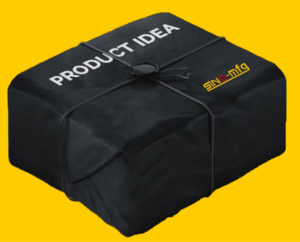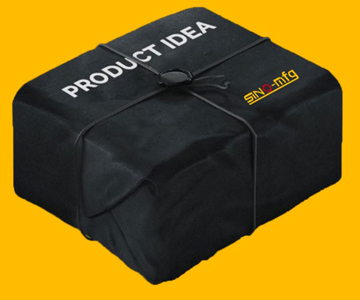Design Guide
Design Guide
WALL THICKNESS
Cost savings are highest when components have a minimum wall thickness, as long as that thickness is consistent with the part’s function and meets all mold filling considerations. As would be expected, parts cool faster with thin wall thicknesses, which means that cycle times are shorter, resulting in more parts per hour. Further, thin parts weigh less, using less plastic per part. On average, the wall thickness of an injection molded part ranges from 2mm to 4mm (.080 inch to .160 inch). Thin wall injection molding can produce walls as thin as 0.5mm (0.020 inch).

UNIFORM WALLS
Parts with walls of uniform thickness allow the mold cavity to fill more easily since the molten plastic does not have to be forced through varying restrictions as it fills.
If the walls are not uniform the thin section cools first, then as the thick section cools and shrinks it builds stresses near the boundary area between the two. Because the thin section has already hardened, it doesn’t yield. As the thick section yields, it leads to warping or twisting of the part, which, if severe enough, can cause cracks.
What if you cannot have uniform walls (due to design limitations)?
1,If design limitations make it impossible to have uniform wall thicknesses, the change in thickness should be as gradual as possible.

2,Coring is a method where plastic is removed from the thick area, which helps to keep wall sections uniform, eliminating the problem altogether.

3,Coring is a method where plastic is removed from the thick area, which helps to keep wall sections uniform, eliminating the problem altogether.


VOIDS AND SHRINKAGE
Troublesome shrinkage problems can be caused by the intersection of walls that are not uniform in wall thickness. Examples might include ribs, bosses, or any other projection of the nominal wall. Since thicker walls solidify slower, the area they are attached to at the nominal wall will shrink as the projection shrinks. This can result in a sunken area in the nominal wall. Such shrinkage can be minimized if a rib thickness is maintained to between 50 and 60 percent of the walls they are attached to. To further our example, bosses located into a corner will produce very thick walls, causing sink, unless isolated as in the illustration below.

WARPAGE
The dynamic of thin and thick sections and their cooling times creates warping as well. As would be expected, as a thick section cools it shrinks, and the material for the shrinkage comes from the unsolidified areas causing the part to warp.
Other causes for warping might include the molding process conditions, injection pressures, cooling rates, packing problems, and mold temperatures. Resin manufacturers’s process guidelines should be followed for best results.

BOSSES
Bosses are used to facilitate the registration of mating parts, for attaching fasteners such as screws, or for accepting threaded inserts.

Wall thicknesses for bosses should be less than 60 percent of the nominal wall to minimize sinking. However, if the boss is not in a visible area, then the wall thickness can be increased to allow for increased stresses imposed by self-tapping screws.

The base radius should be a minimum of 0.25 X thickness. Bosses can be strengthened by incorporating gussets at the base or by using connecting ribs attaching to nearby walls.
RIBS
Ribs are used in a design to increase the bending stiffness of a part without adding thickness. Ribs increase the moment of inertia, which increases the bending stiffness.
Bending Stiffness =?E (young’s Modulus) x I (Moment of Inertia)
Rib thickness should be less than wall thickness to minimize sinking effects. The recommended rib thickness should not exceed 60 percent of the nominal thickness. Plus, the rib should be attached with corner radii as generous as possible.
RIB INTERSECTIONS
Because the thickness of the material will be greater at the rib intersections, coring or another means of material removal should be employed to avoid excessive sinking from occurring on the opposite side.

RIB GUILDELINES
The height of a rib should be limited to less than three times its thickness. It is better to use multiple ribs to increase bending stiffness than to use one very tall rib.

RIB/LOAD AFFECT ON STIFFNESS
A rib is oriented in such a way as to provide maximum bending stiffness to the part. By paying attention to part geometry, designers must be conscious of the orientation of the rib to the bending load or there will be no increase in stiffness.


TEXTURES AND LETTERING
Whether to incorporate identifying information or to include as an aesthetic addition, textures and lettering can be included onto mold surfaces for the end user or factory purposes. Texturing may also hide surface defects such as knit lines and other imperfections. The depth of the texture or letters is somewhat limited, and extra draft needs to be provided to allow for part removal from the mold without dragging or marring the part.
SHARP CORNERS
Sharp corners greatly increase stress concentration, which, when high enough, can lead to part failure. Sharp corners often come about in non-obvious places, such as a boss attached to a surface, or a strengthening rib. The radius of sharp corners needs to be watched closely because the stress concentration factor varies with radius for a given thickness. As illustrated in the chart to the left, the stress concentration factor is high for R/T values less than 0.5, but for R/T values over 0.5 the concentration lowers. The stress concentration factor is a multiplier that greatly increases stress. It is recommended that an inside radius be a minimum of one times the thickness.
In addition to reducing stresses, the fillet radius provides a streamlined flow path for the molten plastic, resulting in an easier fill of the mold.

At corners, the suggested inside radius is 0.5 times the material thickness and the outside radius is 1.5 times the material thickness. A bigger radius should be used if part design allows.

INSERTS
Inserts used in plastic parts provide a place for fasteners such as machine screws. The advantage of using inserts is that they are often made of brass and are robust. They allow for a great many cycles of assembly and disassembly. Inserts are installed in Injection Molded parts using one of the following methods:
ULTRASONIC INSERTION
Ultrasonic insertion is when an insert is “vibrated” into place by using an ultrasonic transducer called the “horn” that is mounted into the ultrasonic device. For optimum performance, the horn is specially designed for each application. Ultrasonic energy is converted to thermal energy by the vibrating action, which allows the insert to be melted into the hole. This type of insertion can be done rapidly, with short cycle times, and low residual stresses. Good melt flow characteristics for the plastic is necessary for the process to be successful.
THERMAL INSERTION
This method uses a heated tool, like a soldering iron, to first heat the insert until it melts the plastic, and then presses the insert into place. As the plastic cools it shrinks around the insert, capturing it. The advantage of this method is that the special tooling is inexpensive and simple to use. Care does need to be taken not to overheat the insert or plastic, which could result in a non-secure fit and degradation of the plastic.
MOLDED-IN
To mold inserts into place during the molding cycle, core pins are used to hold the inserts. The injected plastic completely encases the insert, which provides excellent retention. This process may slow the molding cycle because inserts have to be hand loaded, but it also eliminates secondary operations such as the ultrasonic and thermal insertion methods. Finally, for high volume production runs, an automatic tool can load the inserts but this increases the complexity and cost of the mold.

LIVING HINGES
Living hinges are thin sections of plastic that connect two segments of a part to keep them together and allow the part to “hinge” open and closed. Typically these hinges are incorporated in containers that are used in high volume applications such as toolboxes and CD cases.

Materials used in molding living hinges must be very flexible, such as polypropylene or polyethylene. A well designed living hinge typically flexes more than a million cycles without failure.

Bring your product idea to life as soon as 5 days!

Bring your product idea to life as soon as 5 days!

Bring your product idea to life
as soon as 5 days!